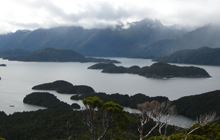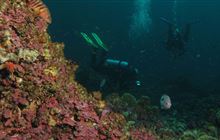Tamatea/Dusky Sound restoration project
Introduction
Located on the wild and remote Fiordland coast, Tamatea/Dusky Sound is the focus of a cutting edge project to see it restored to one of the most intact ecosystems on Earth.A Tamatea/Dusky Sound restoration plan has been developed with the ambitious goals of eradicating pests, re-introducing missing species and filling biodiversity information gaps in the area.
The project area includes Te Puaitaha/Breaksea Sound, Acheron Passage, Wet Jacket Arm, and Tamatea/Dusky Sound itself which has over 700 islands, including Resolution Island, New Zealand’s fifth largest island.
Our vision is for Tamatea/Dusky Sound to be one of the most intact ecosystems on Earth, and New Zealand's largest ‘bio bank’ – a source of endangered native species that can be sent to pest free locations throughout the country.
Video
Why is it so special?
The area is rich in both Māori and European history. From traditional iwi stories, to Captain Cook's landing in 1773. Tamatea/Dusky Sound was also the site of one of the world’s first conservation reserves and New Zealands first conservation ranger, Richard Henry, in the late 19th century.
Tamatea/Dusky Sound’s geographical isolation has assisted it to remain one of the least modified parts of mainland New Zealand, with lush native bush cover and relatively few weeds. Many of Tamatea/Dusky Sound’s islands have never been invaded by the introduced pests that now plague the mainland.
In its current state, Tamatea/Dusky Sound is an outstanding conservation resource that has allowed many vulnerable native birds, skinks, geckos, invertebrates and freshwater species to survive. The area also includes two marine reserves, Taumoana/Five Fingers and Moana Uta /Wet Jacket Arm.
Our work - island projects
Tamatea/Dusky Sound is a pioneer for island sanctuary projects, with many islands having had pest animals removed or reduced to low numbers.
Resolution Island
Because of its large size (c21,000 ha) and possum and rat free status, Resolution Island has a critical role in the success of the entire restoration project. It is the site of a stoat and deer eradication programme, one of the most ambitious pest control programmes in the world.
In 2011 mohua were returned, the first of what is hoped will be a long line of endangered species to find security on this immense island. Resolution Island may also one day be home to populations of takahē and kākāpō.
Controlling pests on smaller islands adjacent to Resolution Island creates more secure habitat for our native species, and helps prevent pests using these smaller islands as ‘stepping stones’ to reinvasion.
Breaksea Island
This island was cleared of rats in 1988 and is now pest free. This was a world first for an island of its size. The many tactics and lessons learned formed the basis for similar pest eradication programmes globally. A wide range of species including tieke, mohua, the knobbled weevil and Fiordland skink have since been transferred to this pest free island paradise and are now thriving.
Anchor Island
This special island was declared pest free in 2005 and is now home to some of our most endangered birds, including one third of the world's kākāpō population. See Kākāpō Recovery
Pigeon Island
This island was declared pest free in 2007 and is a mohua and South Island robin translocation site.
Indian Island and Long island
Indian island was declared pest-free in 2012, but it was reinvaded by rats in 2015/16. The Indian Island/Mamaku Restoration Project aims to reduce the rat population to undetectable levels, and reduce the risk of reinvasion. Pest control on Long Island has started and an intensive trapping network is being established to help protect the outlying islands from reinvasion. See Pure Salt.
Cooper Island
Since 2017, Real Journeys have been removing stoats and rats from Cooper Island. Removal of these predators helps protect important seabird nesting sites on the nearby Shag Islands. See the Cooper Island restoration project.
Real Journeys has also joined DOC's Tamatea/Dusky Sound Restoration Programme to help make the island safe for native birds. They hope this work will support their ambitious vision for the entire ecosystem, that it becomes one of the healthiest in the world and can support national species recovery.
Next steps
The Tamatea/Dusky Sound restoration plan is a 30-year plan with 54 objectives covering: vegetation and habitat mapping, pest animal and weed control, translocations, monitoring, advocacy for additional marine protection and filling information gaps relating to seabirds, mokomoko/lizards, pekapeka/bats, terrestrial invertebrates, freshwater fish, mapping, marine mammals and fragile marine encrusting organisms.
Tamatea/Dusky Sound conservation and restoration plan 2016 (PDF, 4,530K)
You can help
Partner with us
Many conservation projects in Tamatea/Dusky Sound receive support from community groups, businesses and individuals through our partnerships. Partners are involved in a wide range of projects from species translocations, to bird monitoring, and pest control.
All projects have considerable potential for media and public attention, and partners are encouraged to take an active 'hands on' role in the work. Contact us to talk about the opportunities to support the Tamatea/Dusky Sound restoration project.
Volunteer with us
Make a big contribution to conservation and have fun along the way. See Fiordland volunteer activities.
Contact
| DOC Customer Service Centre | |
|---|---|
| Phone | 0800 275 362 |
| teanauadmin@doc.govt.nz | |
| Address | DOC offices |



